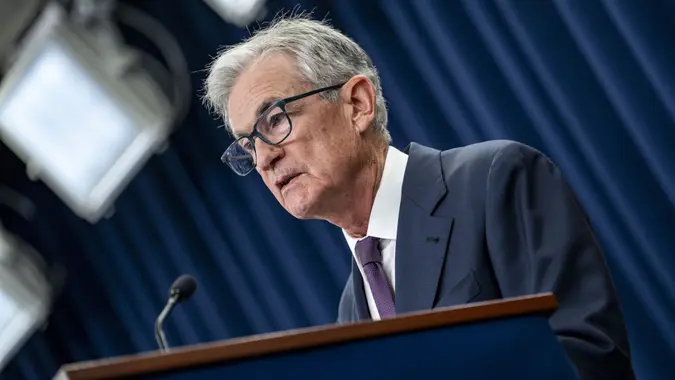How Trump’s Tariff on Movies Could Impact Your Streaming Costs

Commitment to Our Readers
GOBankingRates' editorial team is committed to bringing you unbiased reviews and information. We use data-driven methodologies to evaluate financial products and services - our reviews and ratings are not influenced by advertisers. You can read more about our editorial guidelines and our products and services review methodology.

20 Years
Helping You Live Richer

Reviewed
by Experts

Trusted by
Millions of Readers
President Donald Trump’s proposed 100% tariff on foreign-made movies threatens to increase your streaming subscription costs significantly in the coming months. Americans already spend an average of $69 monthly on video streaming services, representing a 13% increase from last year alone. According to The Wrap’s reporting of Citi analyst Jason Bazinet, Netflix would need to raise average revenue per user by approximately 7% to offset potential production costs.
The tariff directly targets foreign film imports, which comprise roughly 50% of Netflix’s original content library and substantial portions of other platforms. If implemented, the policy could force streaming services to double their content acquisition expenses for international productions. Here’s how these additional costs will inevitably translate to higher subscription fees for American consumers seeking entertainment content.
Major Streaming Platforms Face Billions in Additional Production Expenses
Netflix could face up to $3 billion in additional annual costs under worst-case scenarios, according to Citi analyst Jason Bazinet’s analysis reported by The Wrap. The streaming giant’s stock dropped 4.55% following Trump’s initial announcement, while Disney declined 1.7% and Warner Bros. Discovery fell 2.6%, according to Investing.com. According to The Hill, Netflix dropped around 4% in early morning trading, Disney fell more than 2% and Warner Bros. Discovery was down more than 3%.
Commerce Secretary Howard Lutnick confirmed the administration is actively working on tariff implementation, though specific enforcement mechanisms remain under development, per CBS News. Citi analyst estimated Netflix’s earnings per share could decline by 20% if the company absorbs tariff costs internally. However, most industry observers expect streaming services will protect profit margins by raising subscription prices rather than reducing earnings.
Existing Price Hikes Create Perfect Storm for Consumer Wallets
Streaming services alone cost U.S. households an average of $42 monthly before considering additional entertainment subscriptions. Nearly 60% of American adults are reconsidering paid subscriptions due to budget constraints and price fatigue across multiple service categories.
Many services have already implemented aggressive price increases throughout 2025, with Disney+ raising fees for the fourth consecutive year. According to CBS News, the ad-supported Disney+ plan jumped from $9.99 to $11.99 monthly, while premium subscriptions reached $18.99 in October. Fox Business reported that Apple TV+ announced a 30% price increase in August, moving from $9.99 to $12.99 per month.
Budget-Conscious Viewers Now Turn To Free Alternatives Amid Rising Costs
According to Deloitte’s 2025 Digital Media Trends survey, 49% of consumers currently maintain cable subscriptions, down from 63% three years ago, indicating sustained momentum toward cost-conscious viewing alternatives. If tariffs push streaming costs higher, we could see accelerated subscription cancellations and increased adoption of free viewing alternatives nationwide.
Some viewers use free streaming platforms like Tubi, Pluto TV and Roku Channel to access extensive movie libraries without subscription fees. There are also bundle services through cellular providers or internet companies, as Verizon offers Disney+ packages and T-Mobile includes Netflix with certain plans. Local libraries also provide access to services like Kanopy and Hoopla Digital, delivering high-quality films and educational content at no cost.
Smart Strategies Help Consumers Prepare for Rising Streaming Expenses
Some experts recommend rotating streaming subscriptions monthly to reduce cumulative costs while maintaining access to desired content across different platforms. According to CNET’s subscription management guide, households can save up to $360 annually by subscribing to only one service monthly. Consumers can set calendar reminders to cancel services before renewal dates and avoid paying for unused subscriptions during content gaps.
Another strategy would be downgrading to ad-supported tiers, which typically cost $5 to $7 less monthly than premium plans across major platforms. Consumer research shows that 57% of streaming users are already opting for ad-supported versions to reduce monthly expenses. Furthermore, consumers can also share family plans with household members to split costs, with Netflix’s standard plan supporting two simultaneous streams for $10.99 monthly.
Editor’s note on political coverage: GOBankingRates is nonpartisan and strives to cover all aspects of the economy objectively and present balanced reports on politically focused finance stories. You can find more coverage of this topic on GOBankingRates.com.
 Written by
Written by  Edited by
Edited by 

























